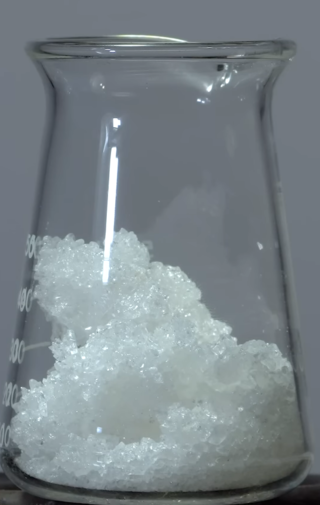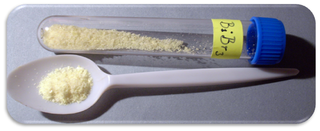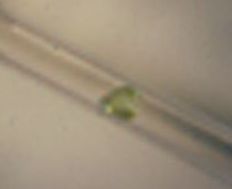
Carbon tetrabromide, CBr4, also known as tetrabromomethane, is a bromide of carbon. Both names are acceptable under IUPAC nomenclature.

Iron(III) bromide is the chemical compound with the formula FeBr3. Also known as ferric bromide, this red-brown odorless compound is used as a Lewis acid catalyst in the halogenation of aromatic compounds. It dissolves in water to give acidic solutions.

Arsenic tribromide is an inorganic compound with the formula AsBr3, it is a bromide of arsenic. Arsenic is a chemical element that has the symbol As and atomic number 33. This pyramidal molecule is the only known binary arsenic bromide. AsBr3 is noteworthy for its very high refractive index of approximately 2.3. It also has a very high diamagnetic susceptibility. It is a poisonous metalloid that has many allotropic forms: yellow and several black and gray forms (metalloids), orthorhombic prisms, colorless rhombic crystals are a few that are seen. Bromine is a halogen element with the symbol Br and atomic number 35. Diatomic bromine does not occur naturally, but bromine salts can be found in crustal rock.

Gallium(III) bromide (GaBr3) is a chemical compound, and one of four gallium trihalides.
Tin(II) bromide is a chemical compound of tin and bromine with a chemical formula of SnBr2. Tin is in the +2 oxidation state. The stability of tin compounds in this oxidation state is attributed to the inert pair effect.
Bromine compounds are compounds containing the element bromine (Br). These compounds usually form the -1, +1, +3 and +5 oxidation states. Bromine is intermediate in reactivity between chlorine and iodine, and is one of the most reactive elements. Bond energies to bromine tend to be lower than those to chlorine but higher than those to iodine, and bromine is a weaker oxidising agent than chlorine but a stronger one than iodine. This can be seen from the standard electrode potentials of the X2/X− couples (F, +2.866 V; Cl, +1.395 V; Br, +1.087 V; I, +0.615 V; At, approximately +0.3 V). Bromination often leads to higher oxidation states than iodination but lower or equal oxidation states to chlorination. Bromine tends to react with compounds including M–M, M–H, or M–C bonds to form M–Br bonds.
There are three sets of Indium halides, the trihalides, the monohalides, and several intermediate halides. In the monohalides the oxidation state of indium is +1 and their proper names are indium(I) fluoride, indium(I) chloride, indium(I) bromide and indium(I) iodide.

Strontium bromide is a chemical compound with a formula SrBr2. At room temperature it is a white, odourless, crystalline powder. Strontium bromide imparts a bright red colour in a flame test, showing the presence of strontium ions. It is used in flares and also has some pharmaceutical uses.

Bismuth tribromide is an inorganic compound of bismuth and bromine with the chemical formula BiBr3.
Praseodymium(III) bromide is a crystalline compound of one praseodymium atom and three bromine atoms.

Samarium(II) bromide is an inorganic compound with the chemical formula SmBr
2. It is a brown solid that is insoluble in most solvents but degrades readily in air.
Samarium(III) bromide is a crystalline compound of one samarium and three bromine atoms with the chemical formula of SmBr3. Samarium(III) bromide is a dark brown powder at room temperature. The compound has a crystal structure isotypic to that of plutonium(III) bromide.
Europium(III) bromide is a crystalline compound, a salt, made of one europium and three bromine atoms. Europium tribromide is a grey powder at room temperature. It is odorless. Europium tribromide is hygroscopic.
Gadolinium(III) bromide is a crystalline compound of gadolinium atoms and three bromine atoms. This salt is hygroscopic.
Holmium(III) bromide is a crystalline compound made of one holmium atom and three bromine atoms. Holmium bromide is a yellow powder at room temperature. Holmium bromide is hygroscopic. Holmium bromide is odorless.
Thulium(III) bromide is a crystalline compound of one thulium atom and three bromine atoms. The salt is a white powder at room temperature. It is hygroscopic.
Lutetium(III) bromide is a crystalline compound made of one lutetium atom and three bromine atoms. It takes the form of a white powder at room temperature. It is hygroscopic. It is odorless.

Californium(III) bromide is an inorganic compound, a salt with a chemical formula CfBr3. Like in californium oxide (Cf2O3) and other californium halides, including californium(III) fluoride (CfF3), californium(III) chloride, and californium(III) iodide (CfI3), the californium atom has an oxidation state of +3.

Zirconium(III) bromide is an inorganic compound with the formula ZrBr3.









